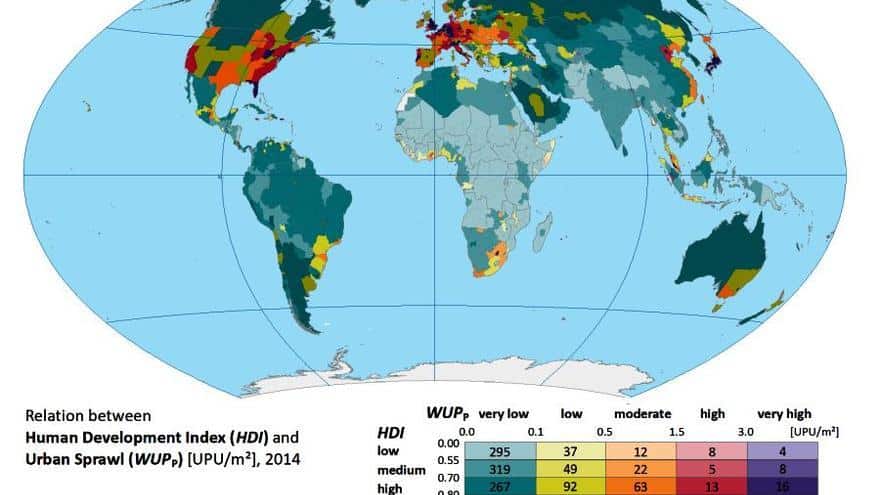By comparing historical satellite data, scientists have found that urban sprawl is skyrocketing worldwide, especially in Europe, North America and Australia. In OECD countries, high levels of urban sprawl per capita reach 90%.
Despite many efforts to contain it, urban sprawl continues to progress dramatically: between 1990 and 2014, it increased by 95% worldwide. The built-up area grew by an average of about 1.2 square kilometers (more than 160 football fields) every hour.
It was discovered in a joint study by scientists from the Leibniz Institute for Urban and Regional Ecological Development (IOER) in Dresden (Germany) and Concordia University in Montreal (Canada), whose results are published in the journal “PLOS Sustainability and Transformation”.
For the first time, this research analyzed the extent and development of urban sprawl worldwide in a comprehensive and comparative manner. This was made possible by new satellite-based global settlement datasets that provide information on built-up areas, according to a release.
UN Geoscheme
This methodology allowed scientists to compare patterns of urban sprawl from broad to increasingly fine scales, in contrast to previous studies.
The scientists calculated urban sprawl for five levels of spatial units according to the UN Geoscheme: continents, regions, countries, subnational regions (such as provinces or states), and a regular grid with a cell size of 50 x 50 km2.
The measure of urban sprawl applied in the analyses includes three components: the proportion of built-up areas in a research area, the dispersion of built-up areas, and the density of settlement. These parameters indicate the extent to which the landscape is permeated by the expansion of human settlement areas.
Europe is a protagonist
The research team discovered surprising results for Europe: the old continent was not only the most dispersed in 2014, but, in a comparison of continents between 1990 and 2014, it also recorded the greatest urban sprawl.
The results also revealed that, in many parts of the world, urban sprawl continues to increase, especially in conurbations (regions comprising a number of cities, large towns and other urban areas), for example, through increased dispersed and low-density development on the outskirts of large cities.
The trend is also visible in many coastal regions that are attractive to tourists, such as along the French Riviera.
Expansion per capita
The study included a measure that determines how much, on average, each individual contributes to urban sprawl by occupying land (urban sprawl per capita).
In terms of per capita values, North America, Australia and again Europe show by far the highest values.
Overall, urban sprawl is found to be highest in the most developed countries: the more knowledge and planning capabilities societies have at their disposal, the more common the emergence of large urban sprawl is observed, the researchers point out.
What most concerns the scientists are their findings on the relationship between the level of human development and the extent of the trend, due to the environmental impact.
Better balance
“For a more sustainable future, it will be important to find a better balance between high quality of life and economic land use,” the authors write in their article.
The systems, regulations and planning measures that have existed in industrialized countries for a long time have not been able to stop urban sprawl so far, they emphasize,
According to the scientists, there is an urgent need for further comparative studies on effective instruments for moderating development, for which the global results presented could be a starting point.
Reference
Rapid rise in urban sprawl: Global hotspots and trends since 1990. Martin Behnisch et al. PLOS Sustain Transform 1(11): e0000034. DOI:https://doi.org/10.1371/journal.pstr.0000034
How urban sprawl is articulated
Experts speak of urban sprawl when settlements expand in a dispersed manner into neighboring areas and thus often into agricultural or natural areas.
Dispersed areas are generally characterized by low building density. This means that comparatively few buildings occupy a disproportionately large area.
Due to the need to connect and provide infrastructure to these areas, the trend is accompanied by many negative environmental and climate consequences.
These effects include the sealing off of valuable land by buildings, roads, and utility infrastructure. Urban sprawl leads to increased fragmentation of wildlife habitats, which threatens biodiversity and ecosystem resilience and the provision of ecosystem services. It also leads to excessive consumption of natural resources (building materials).
Among the policy objectives related to sustainable development at global, European and national levels, sustainable land use and thus the reduction of urban sprawl is mentioned as an important point.
The new study shows that clearly stronger and novel efforts are needed to achieve these objectives.
For the full article, please visit Diario de Ibiza website here.

